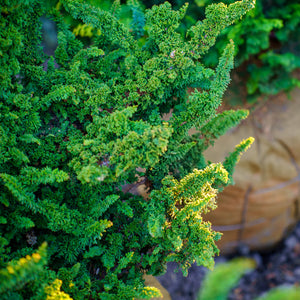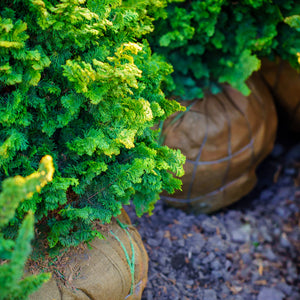The Chamaecyparis Guide
Chamaecyparis, commonly known as False Cypress, is a diverse genus of needled evergreens that adds texture, color, and structure to the landscape. With graceful forms ranging from dwarf, mounding varieties to stately columnar selections, Chamaecyparis cultivars are valued for their soft foliage, varied hues, and adaptability. These evergreens are ideal for borders, foundation plantings, focal point specimens, and even topiary. Their refined, layered texture makes them standout performers in both formal and naturalistic designs.
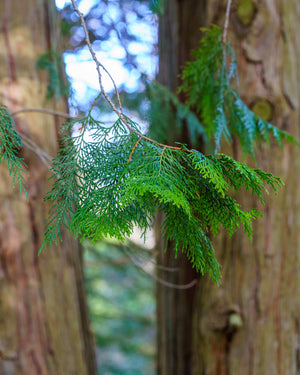
About
Chamaecyparis belongs to the Cupressaceae family and includes several species used ornamentally, including Chamaecyparis obtusa (Hinoki Cypress) and Chamaecyparis pisifera (Sawara Cypress). Native to Japan and Taiwan, these conifers offer a wide range of foliage colors—from golden yellows to silvery blues—and growth habits that suit nearly every garden style.
Dwarf varieties like Chamaecyparis obtusa 'Nana Gracilis' and Chamaecyparis pisifera 'Golden Mop' make excellent foundation plants or container specimens. For a bolder look, upright cultivars such as Chamaecyparis obtusa 'Crippsii' and Chamaecyparis obtusa 'Gracilis' develop into elegant, narrow pyramids with rich green or golden tones. Threadleaf types like Chamaecyparis pisifera 'Filifera Aurea' and Chamaecyparis pisifera 'Sungold' offer soft, cascading foliage that adds movement and contrast.
False Cypress is a go-to evergreen for year-round interest, thriving in both full sun and partial shade depending on the cultivar. Many varieties are slow-growing, making them excellent long-term choices for low-maintenance gardens.
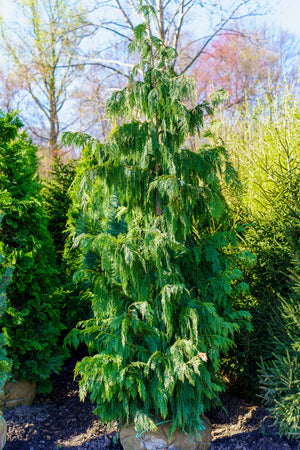
PLANTING
Chamaecyparis can thrive in a variety of garden settings if planted with care. Their root systems prefer consistent moisture but cannot tolerate waterlogged soils.
USDA Hardiness Zones: Most varieties grow well in Zones 4–8, though cold tolerance varies by cultivar.
Soil: Prefers moist, well-drained, slightly acidic soil. Avoid heavy clay or overly wet areas.
Sunlight: Full sun is ideal for best color and compact growth, but many cultivars tolerate partial shade.
Watering: Water regularly during establishment and during dry periods. These evergreens are not drought-tolerant until fully established.
Spacing: Depends on mature size—dwarfs like 'Nana Lutea' can be spaced 2–3 feet apart, while upright forms like 'Gracilis' may need 6–10 feet.
Planting Time: Spring or early fall is ideal to allow roots to establish before extreme heat or cold.
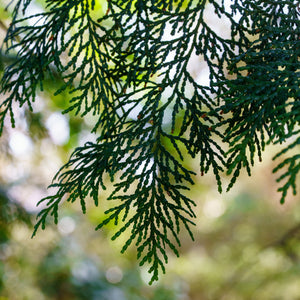
CARE
Chamaecyparis is relatively low-maintenance once established, though it benefits from seasonal attention to ensure healthy growth and form.
- Watering: Provide consistent moisture, especially during dry spells. Mulching helps retain soil moisture and insulate roots.
- Fertilizing: Apply a balanced, slow-release fertilizer in early spring. Avoid high-nitrogen products that encourage weak, leggy growth.
- Pruning: Minimal pruning is needed. Light shaping can be done in early spring. Avoid cutting into old wood, as False Cypress may not resprout from bare branches.
- Mulching: Keep a 2–3 inch mulch layer around the base to regulate soil moisture and temperature.
- Pests & Diseases: Generally pest-resistant. Watch for spider mites in hot, dry weather. Root rot can occur in poorly drained soils.
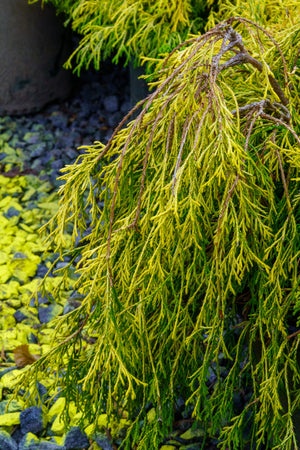
HOW TO USE
Chamaecyparis adds year-round appeal and architectural structure, making it a standout in any landscape. Whether used as a tidy accent or a sweeping feature, these evergreens are adaptable to many roles:
- Focal Points: Upright varieties like Chamaecyparis obtusa 'Crippsii' or Chamaecyparis obtusa 'Gracilis' serve as stunning focal points in front yards, entryways, or mixed beds.
- Foundation Plantings: Dwarf types such as 'Nana Gracilis' or 'Golden Mop' provide long-lasting structure without overwhelming the space.
- Borders & Hedges: Varieties like 'Filifera Aurea' or 'Vintage Gold' can create soft, mounding borders with seasonal color shifts.
- Rock Gardens or Containers: Compact, slow-growing types like 'Butter Ball' and 'Dainty Doll' are ideal for rock gardens or patio containers.
- Companion Plantings: Pairs beautifully with perennials such as Heuchera, Helleborus, and Hakonechloa, as well as flowering shrubs like Hydrangea paniculata and Pieris japonica.
Whether you're creating a modern landscape or a woodland-inspired retreat, Chamaecyparis brings reliable evergreen presence and focal point-worthy form.
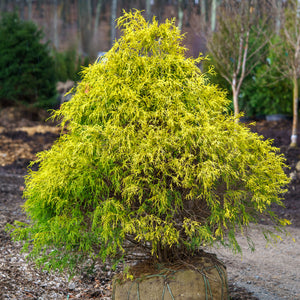
COMMON QUESTIONS
Is Chamaecyparis poisonous to cats or dogs? No, Chamaecyparis is not considered toxic to cats or dogs. However, ingestion of large amounts of any plant material can cause mild digestive upset.
How big does Chamaecyparis grow? Mature size varies significantly by cultivar—from under 3 feet tall for dwarf types to 30 feet or more for upright varieties.
Can Chamaecyparis be pruned? Yes, but pruning should be light and selective. Avoid hard pruning into old wood, as it may not regenerate.
What is a Chamaecyparis? Chamaecyparis is a genus of needled evergreen conifers known as False Cypress, popular in landscaping for their refined texture and varied colors.
How to care for Chamaecyparis? Provide consistent moisture, full sun to part shade, and good drainage. Minimal pruning and occasional feeding keep them looking their best.
Conclusion
Chamaecyparis offers a graceful, dependable option for evergreen structure in the landscape. From compact mounds to elegant, upright specimens, these versatile conifers adapt to a variety of uses and climates. Their soft foliage, rich colors, and year-round form make them ideal for gardeners seeking low-maintenance, focal point-worthy evergreens that anchor and elevate surrounding plantings.
The Chamaecyparis Collection
Sold Out
Sold Out
Sold Out
Sold Out
Sold Out




